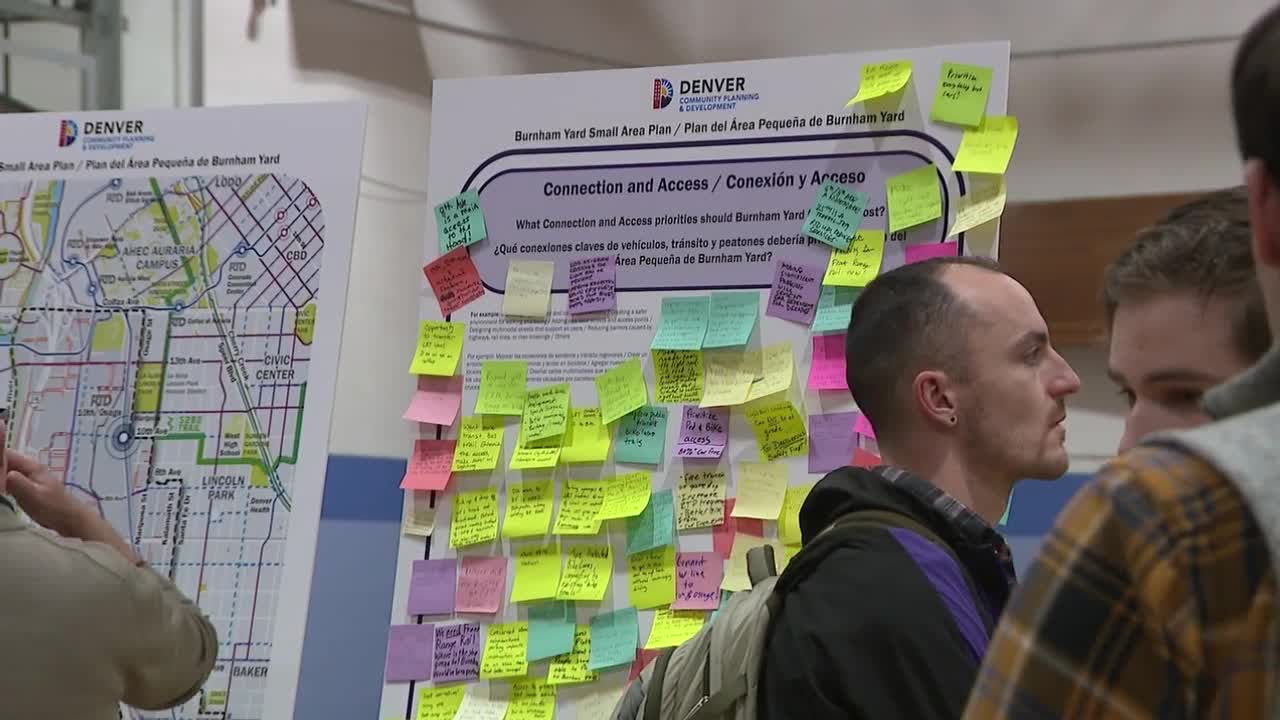DENVER — The future of Denver’s Burnham Yard site starts with plans for the new home of the Broncos, but it doesn’t end there.
The city is preparing to transform the decommissioned rail yard into a mix of residential, retail and more to surround the planned retractable roof stadium, which city leaders hope will draw other large-scale events to the city.
At the nearby La Alma Recreation Center Wednesday night, the city kicked off a series of community meetings to hear resident feedback about the new stadium plan, specifically for what the city is calling the Burnham Yard Small Area Plan.
- RELATED: 5,280-foot move? The Broncos have a chance to do a perfectly Denver thing with their new stadium
Hundreds of people showed up to the open house, including the mayor as well as representatives from the city and the Broncos.
The community feedback period is expected to last a year. Wednesday’s meeting focused on broader visions and values, while the next meeting in February is expected to include concept alternatives for the project.

“You'll have activations every single day of the year, it's not just game day,” Denver Mayor Mike Johnston told reporters at the open house. “This will be a great place to live, or to come to dinner at a restaurant, or to come to shop, whether you're coming to a game or not… You'll have activations every single day of the year. It's not just game day.”
Johnston said the project will be “an unprecedented economic boost for this neighborhood and for the city,” and that during the public feedback period people will “have a lot of input into what the types of uses… they want to see here.”
Michael Hughes, a metro resident and transportation advocate with the West Corridor Transportation Management Association, says he wants the stadium “to fit into all the ways that we can travel: train, bus, carpool, all of it.”
“I just imagined that the owners of the Broncos, who travel by private jet because they can, would pick a place where they could land a private jet and walk across the street to a new stadium in a suburban location,” Hughes told Denver7. “So I'm surprised and actually really encouraged that they chose to stay in Denver.”

Hughes says he is confident an expanded RTD station at 10th and Osage on one side of the stadium and plans for Front Range Passenger Rail on the other side will eventually come to fruition and give the project and the nearby neighborhoods much-needed transportation flexibility.
“So far it looks to me like they’re really thinking about this in the way that Coors Field developers and the Rockies thought about it,” he said. “That the building should be part of the city, it should fit into the neighborhood, it should be walkable. The transportation should work for the surrounding neighborhood as well as for the stadium itself. So I’m encouraged that this is gonna fit in really well.”
Johnston says the city wants to “end the era of the old stadiums, where you have a stadium with 80 acres of parking lots around it.”
“What we want is a place that's a great activation on game day, but is a place where people live and work all the time, and that feels like it's connected to the history and the place,” he said.
Several residents in nearby neighborhoods like La Alma-Lincoln Park, however, are wary about the changes the project could bring, including traffic, safety and affordability.

One woman, Misty Lubin-Salazar, raised her concern at the end of Johnston’s press conference, asking him what he can do to assure residents that they won’t be forced out of the community. The two then chatted for a few minutes.
Lubin-Salazar has lived near the proposed stadium site for 15 years, with family in the area for more than 40 years.

“It's definitely an exciting prospect to have the stadium just right down the street, but at the same time, really concerned about the residents that are already here and making sure that we're not going to be driven out by rising property taxes, or making it unaffordable for both home ownership and rental properties as well,” she told Denver7.
Johnston told reporters and Lubin-Salazar that the community feedback process won’t be rushed, and there is time to address those concerns and form a community benefits agreement.
“That is reassuring,” Lubin-Salazar said afterward. “But [they] also need to make sure that there are the right people kind of at the table, that are going to raise awareness and have those conversations with whoever needs to have them.”
The stadium is set to open in 2031.
- Check out the Broncos' full Large Development Review pre-application in the document below:





